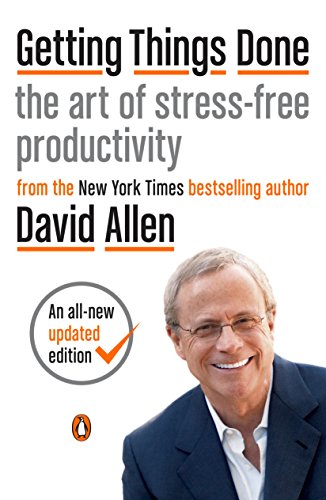

This article is an excerpt from the Shortform summary of "Getting Things Done" by David Allen. Shortform has the world's best summaries of books you should be reading.
Like this article? Sign up for a free trial here .
What is the Getting Things Done program? What is its purpose, and how can it help you become more organized?
The Getting Things Done (GTD) program can help you design a better and more organized life. But first, you need to understand what the Getting Things Done program is for, and its basic principles.
What Is the Getting Things Done (GTD) Program?
The Getting Things Done program is designed to increase your productivity and effectiveness—not so you can squeeze even more into your already busy life, but so that you can do things with less time, energy, and effort. When you feel in control of your life and your to-do list, you can be present in each moment without the nagging feeling that there’s something else you should be doing. When your mind is clear, you can focus and use your creative energy for the task at hand, and in your free moments, you can fully enjoy life without feeling guilty that you’re not doing something “productive.”
The GTD program is meant to be a lifelong practice, and you’ll continually graduate to more advanced levels of application. As you start to cement the strategies as habits, you’ll reach new levels of mastery to enhance your life and productivity in new ways: Once staying on top of your emails is second nature, use your skills (and newfound free time and energy) to take on a new hobby or strengthen your important relationships.
In the meantime, don’t wait until you finish the book to start using the strategies—put them into practice as you go. Practicing the skills will give you a richer understanding and help you dive deeper into the program.
Many readers regularly re-read this book and come away with something new each time. The program requires more habit changes than most people can fully implement all at once, so readers tend to absorb pieces at a time; after the first time through, start practicing the basics, and the next time you’ll better understand the strategies for refining those basic skills. Each time you read the book, you gain a new level of understanding and practice.
The Getting Things Done Program: Don’t Use Outdated Time Management Tools
Significant changes to daily life in the last half-century have overloaded people with work and personal responsibilities, so people need a more dynamic way of managing it all.
First, most people’s jobs are no longer restricted to the hours of 9 am to 5 pm nor to the confines of the office. These days, people are always on call via phone and email, and the effects of globalization mean you could be working with people nine time zones away. There are no boundaries to your workday, so it easily steals time from other parts of your life.
Second, the nature of work has changed from more industrial, assembly-line type work with clear, visible tasks to so-called knowledge work with much more ambiguously defined projects. Previously, you knew what your task was (for example, assemble these parts) and you knew when it was done. Now, one task can eat up a lot of your time because there’s no clear signal when you’re done.
Third, modern life requires near-constant communication with more people. Most organizations require increasing interdepartmental collaboration, so workers are no longer limited to their specifically defined roles and departments. In your personal life, too, there’s more pressure to stay connected with friends and family via the Internet and social media.
People have no clear boundaries to work and personal commitments, leaving them with little to no free time—or making them feel guilty or pulled in other directions when they do carve out free time.
This is where the Getting Things Done program comes in.
Established time management tools were developed to organize life the way it used to be.
- Calendars are only effective at organizing a portion of your life.
- To-do lists and prioritizing strategies can’t keep up with the high volume and wide range of tasks most people have.
You need a system that can accommodate today’s faster pace of life and the information that comes from all directions. A modern organization system needs to incorporate minuscule daily tasks as well as big-picture goals, and it needs to be simple enough to save more time and energy than it requires.
Organize Your Life From the Bottom-Up
Many organizational systems promote organizing your life from the top-down, first determining your goals and values, then breaking that down into the projects and tasks that fall in line with them.
However, a top-down approach often leads to three problems:
- You can easily get too distracted by urgent demands to even stop and think about your big-picture goals.
- You may be so overwhelmed by your day-to-day demands that the thought of incorporating big-picture goals is daunting and stressful.
- Your big-picture goals and values are likely to raise more tasks and to-dos, which adds to your overloaded schedule instead of clarifying and culling it.
Instead, the bottom-up approach that the Getting Things Done program promotes is more feasible: Once you have a system to keep your small-scale tasks under control, it’ll free up your energy, focus, and creativity to consider larger goals. Additionally, big-picture goals will inevitably break down into smaller action steps, which will be easier to tackle if you already have a system in place.
Horizontal vs. Vertical Control
There are two ways to manage your commitments and actions:
- Horizontal control takes stock of your projects and tasks in all areas of your life—from getting your car repaired to finishing a report for work. This requires an organized system that can keep track of everything, helps you call up relevant reminders and information when you need it, and lets you switch your focus quickly and easily.
- Vertical control goes into the details of one specific project or topic. This might be all the details, research, and planning you need to do for a work report or home addition. Vertical control requires a system that lets you organize and easily access plans, notes, and reminders about this one topic.
The GTD program is designed to accommodate both management systems because life requires both horizontal and vertical planning.
Manage Your Actions
Most to-do lists are made up of “stuff”—plans and commitments that you haven’t yet broken down into actionable steps. Lists full of stuff are ineffective and overwhelming.
An effective productivity system doesn’t manage your time, information, or priorities; it manages your actions. The Getting Things Done program teaches you how to take this stuff, give it meaning, and turn it into “next action” steps using three objectives:
- Have a trusted external system (outside your memory) to capture everything you must do, might need to do, or might need later.
- Be decisive about all your tasks and commitments and have a running to-do list of next actions.
- Organize all of the information and to-dos into appropriate categories and contexts.
When you have an organized external system of actionable items and trusted reminders, your brain doesn’t have to juggle all these thoughts and information—which is good because your brain doesn’t do a great job of it anyway.
Research shows that your brain can’t help but continually remind you about all the things you have to do, which is more of a distraction from your current task than a motivator to accomplish those pending tasks. How often do you think of something you need to do at random times when you can do nothing about it? Not only is it ineffective, but it adds to your stress and anxiety about all the things you need to do.
An Effective System Calms and Clears Your Mind
If you throw a pebble into a still pond, how does the water react? Its reaction is directly proportional to the size of the pebble and the force of your throw—the water doesn’t overreact or underreact.
An effective productivity system makes your mind like water, reacting in direct proportion to the size and importance of the task at hand. When your mind is calm and in control, you can attack each task and project in a state of calm focus and productivity—a “flow” state or being “in the zone.”
In contrast, when you get overwhelmed and don’t feel in control of your life and to-do list, it’s easy to overreact to small demands and underreact to important ones (for example, flipping out when your boss adds a relatively small task to your plate, or not putting enough energy into an important presentation because you’re too overloaded).
Many people live in a constant state of at least mild stress because they don’t have the tools to manage everything. The GTD program gives you the tools to regain control so that you can access that water state of mind.
The Getting Things Done (GTD) program takes time and patience to perfect. You have to work at it every day. But if you master it, the Getting Things Done program can make significant improvements to your life.

———End of Preview———
Like what you just read? Read the rest of the world's best summary of David Allen's "Getting Things Done" at Shortform .
Here's what you'll find in our full Getting Things Done summary :
- Why you're disorganized and your to-do list is a mess
- The simple workflow you can do everyday to be more productive than ever
- How to take complicated projects and simplify them






